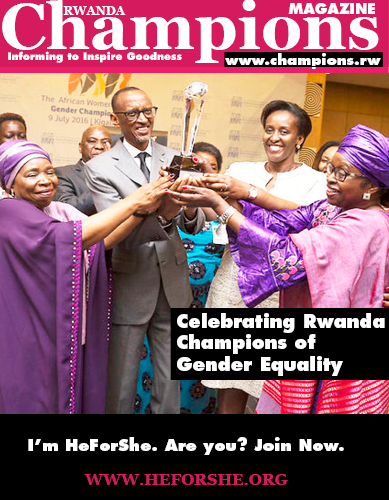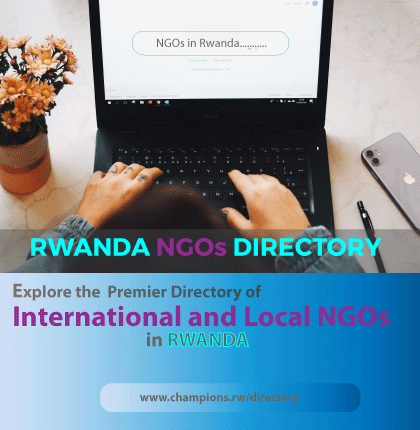African Women Leaders Urge Unity to Bridge Gender Gap in Leadership
African women leaders are calling for greater solidarity and collaboration to help more women attain leadership (…)

By Bosco Kagaba
Tripling girls’ enrolment in Technical and Vocational Education and Training (TVET) to advance women’s employment opportunities is the second out of three commitments Rwanda made under the HeForShe solidarity movement for gender equality. With this commitment, the government believes that equipping girls with the right technical vocational skills will increase their ability to increase their earnings through decent employment or their ability to create their own employment based on their acquired hands-on skills.
In the broader sense, this commitment will help to increase women’s livelihoods and reduce the economic inequality between men and women. This could drastically reduce family conflicts based on economic inequality as it also helps the government to meet its economic development projections.
Looking at how the government continues to implement the TVET policy, it is evident that integrating girls and women into the current situation will result into an accelerated pace although the number of girls joining TVET program remains smaller than the number of boys coming on board. However, based on the available government statistics, there are some academic specializations in TVET where the number of girls is almost equal the number of boys.
However, this commitment along with the first commitment of HeForShe which seeks to reduce the gender digital divide by increasing girls’ access to ICT, usage and innovation seek to ensure that girls go beyond the academic trades in which they are traditionally expected to take part and enroll into the more demanding trades that have for years been literally reserved for boys. These include TVET programs which focus on practical aspects of learning and the tough subjects such as Science, Technology, Engineering and Math (STEM).
Building a strong TVET Backbone
The government of Rwanda has strongly prioritized the implementation of TVET policy in its second Economic Development and Poverty Reduction Strategy (EDPRS 2) for reasons that include building a critical mass of skilled personnel to increase employability of the Rwandan youth and to enable them to create their own jobs and employ others. The ripple effect of this policy is to boost productivity of the individuals and the corporate sector (both service and industrial sectors) in order to boost economic development for greater prosperity.
To achieve the TVET policy objectives, the government embarked on building TVET schools and encouraging the private sector to invest in such training facilities. The government also equipped the TVET institutions with the right equipment and the private sector was requested by the policy to do the same in order to ensure the quality of the graduates from these institutions was surely high and reliable.
According to the Workforce Development Authority (WDA), a public institution that ensures smooth implementation of the TVET policy, in 2016 TVET program was running at different qualification levels and Rwanda had more than 390 TVET schools across the country with at least 3 schools in each district. These schools were handling more than 94,373 students per year including women in 2016.
Through the Workforce Development Authority, Rwanda boasts of more than 98 competent based training curriculum aligned to the country’s technical qualification framework. The number of students enrolling into TVET Programs has also been on the rise since 2010, thanks to the new curriculum. For-example, in 2010, the number of students who enrolled in TVET stood at 51,773 and increased to 83,839 in 2013. And at the center of these figures, were women enrolling in various trades taught under the TVET program.
Attracting Girls into TVET Programs
According to Jerome Gasana, the Director General of WDA, empowering women through vocational training and other Gender aspects is a long-term policy of the government of Rwanda.
And to boost the number of girls joining TVET, a new project code named ‘Adolescent Girls Initiative (AGI) was launched in 2011 to further help girls dealing with difficult situations and equip them with employable hands on skills. Statistics from WDA further indicate that Rwanda’s female population in vocational training centers increased by almost 35% in the last 5 years up to 2016.
Fred Nkurunziza, a trainer at VCT Bumbogo in Gasabo District explains that under this arrangement private institutions are also compelled to ensure that there is gender balance.
“We are aware of this initiative and we closely work with WDA. Currently we have two courses but the third is expected to start in December 2016. Right now we are doing food processing and culinary art but our focus is only on girls for now,” explains Nkurunziza.
Female students in technical secondary school level are estimated at 46% while at Polytechnic level female students make up 18%. According to WDA, out of 112,952 students who have so far graduated in TVET courses since 2011, more than 56,865 students (slightly above 50%) are women. This therefore paints a clear picture on which direction the country is taking when it comes to integrating women into TVET program.
The increasing number of women graduating from TVET is directly linked to the rising number of entrepreneurship and startups across the country, something that inspires more girls to join the TVET program.
The number of girls enrolling for TVET classes has been increasing with figures indicating more than 32,076 girls enrolling in 2011, 33,999 in 2012, 36,149 in 2013 and 40,655 in 2014 and 39,461 in 2015.
Despite the multiplier effect in terms of bridging the skills gap, Geoffrey Kamanzi, the Director of Trade Facilitation and Negotiations at the Private Sector Federation (PSF) says that the numbers of girls enrolling in TVET schools are relatively still small when compared to the need. This is true especially when you compare with more than 54,912 male students who enrolled in 2015 alone.
However, efforts to increase girls in TVET programs are generating results. For example, of the 20,937 students who undertook training in vocational centers in 2015, more than 7,913 were girls, indicating how the girls continue to pick interest in TVET program. The country also boats of more than 987 TVET female trainers who are at the heart of these training programs.
Desire Nimpano, the director of project management and planning at WDA says through TVET system, female students have been exposed to real life skills thus making them more competitive and employable.
Future Plans
The government wants to increase the number of students taking TVET to at least 60 per cent by 2018 and the majority of the students should be girls, according to WDA Director General Jerome Gasana.
“More students especially girls have joined TVET and to have a more realistic picture we are currently trying to factor them in our data to see where we are standing currently. Also basing on the figures from in 2015, I believe we are so close to our target,” Gasana said.
Gasana further explained that each year when new students join TVET adjustments in courses are made to ensure that relevance towards the labor market is maintained. He says that over the past years, government has been introducing new courses along the way to help attract more girls into the system.
Bridging the skills gap
A new study on Vocational Education conducted last year indicated areas where the training is paying off and what more needs to get done to get the best out of the program. One of the issues raised was that fresh TVET graduates find it hard to get jobs for lack of experience.
The study shows that only 18.1 percent of respondents reported that they think that TVET graduates were likely to get a job immediately after they complete training, against 81.9 percent who said that they were not likely to.
Meanwhile, government says it is targeting to have an integrated polytechnic center in every province and at least three technical secondary schools per district.
However due to limited resources, the idea is to encourage private sector to invest in TVET programs as part of the strategy to bridge the current skills gap. The strategy according to WDA is already paying off with TVET schools across the country increasing from 63 in 2010 to 390 in 2015 of which 64 per cent or 248 are privately owned.
And to increase the competence of trainers, the Training of trainers Institute was last year established in Kicukiro District. More so, in 2017 government and private sector hope to open more 3 big schools in Muhanga, Rulindo and Nyabihu Districts. All these are expected to boost the capacity but also encourage more girls to start looking at TVET as a field that can shape their future.
Diogene Mulindahabi, the Principle of IPRC Kicukiro, one of the leading public TVET institutions, says that focusing on girls will uplift the standards of TVET education.
“We might have been fortunate to have some development partners, but training our own people means students including girls will benefit a lot. The growth in infrastructure will also ensure that as students increase, we are able to maintain the desirable quality,” says Mulindahabi.
Incentives to Attract Girls To Join TVET
IPRC Kicukiro conducts awareness campaigns in secondary schools to ensure that majority of young people who join TVET are girls. “Even when they join the school, the first thing we hold is an open day where we ensure that the similar messages are extended to all students,” explains Mulindahabi. He adds that on top of such campaigns, girls are provided incentives to ensure that many reside on campus.
“Both boys and girls are accommodated at the campus but when we get requests, priority is given to the girls. We believe that this contributes towards encouraging females in TVET,” he says.
However, Paul Swagga, a tutor at Akilah Institute for Women advises that the issue of gender parity in TVET needs a holistic approach from both administrators of institutions and stakeholders to address it.
“Most students join at a time when they are naïve about everything. It is important that awareness campaigns are organized to warn individuals against gender stereotypes that keep communities behind. Women should not be discouraged by beliefs that some courses are meant for men,” he explains.
Female TVET graduates speak out
Monique Uwizeyimana, a construction engineering student at Groupe Scolaire Des Parents (GSP) Huye - a technical secondary school in Huye District says she chose vocational education because she wanted to boost her entrepreneurship skills and become a job creator not a job seeker.
Hope Mutoni, a student in electronics department at IPRC Kigali was motivated by the success stories of women who graduated from TVET and are competing favorably in the market.
Ingabire Karuranga another construction engineer and a graduate of TVET program from IPRC -South says when powered by opportunity, women have a chance to work their way out of poverty and transform their lives.
African women leaders are calling for greater solidarity and collaboration to help more women attain leadership (…)
Women for Women International (WfWI) has appointed Nigerian development expert Thelma Ekiyor as its new global chief (…)
Minister of Gender and Family Promotion, Consolée Uwimana, told rural women Wednesday that living in the countryside (…)
Rwanda’s First Lady, Jeannette Kagame, has been honored with the FIGO Distinguished Recognition Award in Women’s (…)

